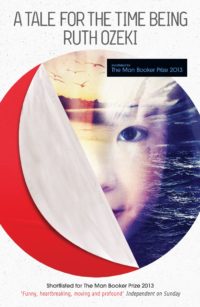Time interacts with attention in funny ways
 A Tale for the Time Being
A Tale for the Time Being
by Ruth Ozeki
I bought this book because it had good reviews and is set in Tokyo – and what better way to prepare for a holiday? It’s a strange story, with unusual narrators and perspectives, and I really do feel that it gave me some insights into life in Tokyo.
The story opens with Naoko, a 16-year-old girl, who is sat in a Tokyo cafe directly addressing her reader. She says that she is a time being and that she plans to write for her reader the story of her 104-year-old great grandmother Jiko before she dies.
Nao is confrontational, sarcastic and has a very dark sense of humour. She texts stories to Jiko about dead prostitutes, which is especially odd because Jiko is a Buddhist nun, formerly a feminist anarchist novelist, now living in a temple in the mountains north of Tokyo.
“We were right in the middle of Tokyo, but when you got close to the temple, it was like stepping into a pocket of ancient humid air, which had somehow gotten preserved like a bubble in ice, with all the sounds and smells still trapped inside it. I read about how the scientists in the Arctic, or the Antarctic, or somewhere really cold, can drill way down and take ice core samples of the ancient atmosphere that are hundreds of thousands or even millions of years old. And even though this is totally cool, it makes me sad to think of those plugs of ice, melting and releasing their ancient bubbles like tiny sighs into our polluted twenty-first century air. Stupid, I know, but that’s the way the temple felt to me, like a core sample from another time.”
In the next chapter it gets weirder: we meet Nao’s reader, Ruth, a novelist living on an island in British Columbia, who found a notebook, a diary, some letters and an old watch in a Hello Kitty lunchbox that washed up on the beach near her house.
Both Nao and Ruth have complex home lives. Nao, though born in Japan, spent most of her childhood in California and has found the last two years back in Tokyo very tough. Her father lost his job in the USA and they have been struggling to get by financially. Nao is bullied badly at school and has gradually lost contact with her best friend in California.
Ruth’s husband Oliver is a conservationist replanting woodland and loves their island unreservedly, despite nosy neighbours, unreliable Internet, power outages and dangerous wildlife. Ruth misses the bustle of New York and wishes she could split her time between the two, but to afford to do that she needs to get writing. (Incidentally, or perhaps not so incidentally, there is an element of auto fiction going on here. The character Ruth, like the book’s author Ruth, had a Japanese mother but was raised in the USA. Ozeki’s husband is indeed called Oliver and “she splits her time between NYC and British Columbia”.)
“Time interacts with attention in funny ways.
At one extreme, when Ruth was gripped by the compulsive mania and hyperfocus of an Internet search, the hours seemed to aggregate and swell like a wave, swallowing huge chunks of her day.
At the other extreme, when her attention was disengaged and fractured, she experienced time at its most granular, wherein moments hung around like particles, diffused and suspended in standing water.”
There is a light, humorous tone to the narration that some readers might find at odds with the subject matter, which is largely very dark. I loved it. If I’m going to read about war, natural disasters, bullying and suicide, I’d much rather experience it like this. That’s not to say this book never gets upsetting. More than once I was blinking back tears in a cafe on my lunch break thanks to this book. And I love it all the more for that.
There is also a spiritual side to the book, which plays with ideas of time and quantum physics through the lens of Zen Buddhism. Which probably sounds crazier than it reads on the page. When I see a literary novelist introduce Schrödinger’s cat or, more commonly, parallel worlds, I tend to get a sinking feeling. But Ozeki handles it (and explains the physics) pretty well (and I have edited a lot of descriptions of quantum physics concepts in my day job).
If you’re not a fan of weird or experimental fiction, then there’s a chance you’ll hate this, but I loved it. Not because it’s weird and experimental, but because I loved the characters.
Published 2013 by Canongate.
Source: Waterstones Exeter.